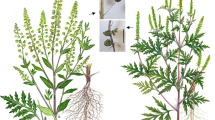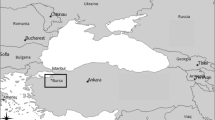Abstract
Ambrosia artemisiifolia L., known as common ragweed, is an invasive and allergenic plant that has begun to expand its presence in Turkey. Although ragweed pollen has been monitored for a long time—especially in the atmosphere of cities in Northern Anatolia—the invasion of the plant is more limited compared to that of other European countries. Here, we present the highest ragweed pollen concentration recorded in Turkey, as well as changes in the Amb a 1 allergen level in the air during 2015 and 2016 in Zonguldak, measured using a BGI 900 cascade impactor. The Seasonal Pollen Integral (SPIn) was found to be 709 pollen day/m3 and 1542 pollen day/m3 in 2015–2016, respectively. The sum of Amb a 1 in both stages was 8.42 × 10−3 U/m3 and 13.1 × 10−3 U/m3 over the same period. The number of days in which the Ambrosia pollen concentration was higher than 50 pollen/m3 doubled in 2016 compared to 2015, despite the negative effect of rainfall on pollen and allergen concentration in 2016. The pollen and allergen sources were evaluated by using simulated air mass movement with a Hybrid Single-Particle Lagrangian Integrated Trajectory model. Our findings suggest that individuals in Zonguldak are exposed as much to pollen—and possibly allergens—transported from the Ukraine, Russia and to a limited extent from Moldova. Furthermore, the allergen content of pollen in Zonguldak was much higher than other cities where Amb a 1 is monitored. We also demonstrated that the date of the peak pollen day may be an indicator of the source of long distance transportation.





Similar content being viewed by others

References
Aboulaich, N., Trigo, M. M., Bouziane, H., Cabezudo, B., Recio, M., El Kadiri, M., et al. (2013). Variations and origin of the atmospheric pollen of Cannabis detected in the province of Tetouan (NW Morocco): 2008–2010. Science of the Total Environment,443, 413–419.
Aksoy, N., Kaplan, A., Özkan, N. G., & Aslan, S. (2010). Some invasive plants in the Western Black Sea region of Turkey and their monitoring possibilities. In 2nd International Workshop on Invasive Plants in Mediterranean Type Regions of the World. Book of Abstract p. 72 Trabzon 2010.
Alan, Ş., Şahin, A. A., Sarışahin, T., Şahin, S., Kaplan, A., & Pınar, N. M. (2018). The effect of geographical and climatic properties on grass pollen and Phl p 5 allergen release. International Journal of Biometeorology,62, 1–13.
Aslan, S., Şahin, B., & Vural, M. (2013). Kızılırmak deltasından bazı nadir türler ve önemli kayıtlar. Biyoçeşitlilik Sempozyumu Bildiri Kitabı. Muğla, 202–7.
Behçet, L. (2004). A new record for the flora of Turkey: Ambrosia tenuifolia Spreng (Compositae). Turkish Journal of Botany,28(1–2), 201–203.
Bıçakçı, A., & Tosunoğlu, A. (2015). Allergenic Ambrosia (Ragweed) Pollen Concentrations in Turkey. Asthma Allergy Immunology,13(1), 33–46.
Buters, J. T. M., Thibaudon, M., Smith, M., Kennedy, R., Rantio-Lehtimäki, A., Albertini, R., et al. (2012). Release of Bet v 1 from birch pollen from 5 European countries. Results from the HIALINE study. Atmospheric Environment,55, 496–505. https://doi.org/10.1016/j.atmosenv.2012.01.054.
Byfield, A. J., & Baytop, A. (1998). Three alien species new to the flora of Turkey. Turkish Journal of Botany,22(3), 205–208.
Cecchi, L., Testi, S., Campi, P., & Orlandini, S. (2010). Long-distance transport of ragweed pollen does not induce new sensitizations in the short term. Aerobiologia,26(4), 351–352. https://doi.org/10.1007/s10453-010-9164-0.
Celenk, S. (2019). Detection of reactive allergens in long-distance transported pollen grains: Evidence from Ambrosia. Atmospheric Environment,209, 212–219.
Celenk, S., & Malyer, H. (2017). The occurrence of Ambrosia pollen in the atmosphere of Northwest Turkey: investigation of possible source regions. International Journal of Biometeorology,61(8), 1499–1510. https://doi.org/10.1007/s00484-017-1328-y.
Cox, L., Li, J. T., Nelson, H., & Lockey, R. (2007). Allergen immunotherapy: A practice parameter second update. Journal of Allergy and Clinical Immunology,120(3), S25–S85.
D’Amato, G., Cecchi, L., Bonini, S., Nunes, C., Annesi-Maesano, I., Behrendt, H., et al. (2007). Allergenic pollen and pollen allergy in Europe. Allergy,62(9), 976–990.
Fumanal, B., Chauvel, B., & Bretagnolle, F. (2007). Estimation of pollen and seed production of common ragweed in France. Annals of Agricultural and Environmental Medicine, 14(2), 233–236.
Galán, C., Ariatti, M., Bonini, M., Clot, B., Crouzy, B., Dahl, A., et al. (2017). Recommended terminology for aerobiological studies. Aerobiologia,33(3), 293–295.
Galán, C., Cariñanos, P., Alcázar, P., & Domínguez-Vilches, E. (2007). Spanish aerobiology network (REA): Management and quality manual (pp. 1–300). Córdoba: Servicio de publicaciones de la Universidad de Córdoba.
Grewling, Ł., Bogawski, P., Jenerowicz, D., Czarnecka-Operacz, M., Šikoparija, B., Skjøth, C. A., et al. (2016). Mesoscale atmospheric transport of ragweed pollen allergens from infected to uninfected areas. International Journal of Biometeorology,60(10), 1493–1500. https://doi.org/10.1007/s00484-016-1139-6.
Hamaoui-Laguel, L., Vautard, R., Liu, L., Solmon, F., Viovy, N., Khvorostyanov, D., et al. (2015). Effects of climate change and seed dispersal on airborne ragweed pollen loads in Europe. Nature Climate Change,5(8), 766–771. https://doi.org/10.1038/nclimate2652.
Jones, E., Oliphant, T., & Peterson, P. (2014). {SciPy}: open source scientific tools for {Python}.
Kaplan, A., Sakiyan, N., & Pinar, M. N. (2003). Daily ambrosia pollen concentration in the air of Ankara, Turkey (1990–1999). Acta Botanica Sinica,45(12), 1408–1412.
Kasprzyk, I., Myszkowska, D., Grewling, Ł., Stach, A., Šikoparija, B., Skjøth, C. A., et al. (2011). The occurrence of Ambrosia pollen in Rzeszów, Kraków and Poznań, Poland: investigation of trends and possible transport of Ambrosia pollen from Ukraine. International Journal of Biometeorology,55(4), 633–644.
Lake, I. R., Jones, N. R., Agnew, M., Goodess, C. M., Giorgi, F., Hamaoui-Laguel, L., et al. (2016). Climate change and future pollen allergy in Europe. Environmental Health Perspectives,125(3), 385–391.
Lockey, R. F., & Ledford, D. K. (2014). Allergens and Allergen Immunotherapy: Subcutaneous, Sublingual, and Oral (5th ed.). Boca Raton: CRC Press.
Makra, L., Matyasovszky, I., Hufnagel, L., & Tusnady, G. (2015). The history of ragweed in the world. Applied Ecology and Environmental Research,13(2), 489–512.
Önen, H. (2015). Türkiye İstilacı Bitkiler Kataloğu. Ankara: T.C. Gıda Tarım ve Hayvancılık Bakanlığı. ISBN: 978-605-9175-05-0.
Önen, H., Günal, H., & Özcan, S. (2014). The Black Sea highway: the route of common ragweed (Ambrosia artemisiifolia L.) invasion in Turkey. In Proceedings of the 8th International Conference on Biological Invasions from Understanding to Action Antalya, Turkey (Vol. 76).
Özaslan, C., Önen, H., Farooq, S., Günal, H., & Akyol, N. (2016). Common ragweed: An emerging threat for sunflower production and human health in Turkey. Weed Biology and Management,16(1), 42–55.
Portnoy, J., & Barnes, C. (2003). Clinical relevance of spore and pollen counts. Immunology and allergy clinics of North America,23(3), 389–410.
Rodinkova, V., Palamarchuk, O., Toziuk, O., & Yermishev, O. (2018). Modeling hay fever risk factors caused by pollen from Ambrosia spp. using pollen load mapping in Ukraine. Acta Agrobotanica. https://doi.org/10.5586/aa.1742.
Ropkins, K., & Carslaw, D. C. (2012). Openair-data analysis tools for the air quality community. R Journal, 4(1), 20–29.
Serbes, A. B., Kaplan, A., Aksoy, N., Özdoğan, Y., & Güneş, N. (2008). Düzce ili atmosferinin polen analizi. Ulusal Hava Kalitesi Sempozyumu Bildiri Kitabı, Ed. Aydın ME, Özcan 2008; 567-8, Konya.
Skjøth, C. A, Šikoparija, B., & Jäger, S. (2013). Pollen sources. In Allergenic pollen (pp. 9–27). Springer.
Smith, M., Cecchi, L., Skjøth, C. A., Karrer, G., & Šikoparija, B. (2013). Common ragweed: A threat to environmental health in Europe. Environment İnternational,61, 115–126.
Sommer, J., Smith, M., Sikoparija, B., Kasprzyk, I., Myszkowska, D., Grewling, L., et al. (2015). Risk of exposure to airborne ambrosia pollen from local and distant sources in Europe-an example from Denmark. Annals of Agricultural and Environmental Medicine, 22(4), 625–631.
Stein, A. F., Draxler, R. R., Rolph, G. D., Stunder, B. J., Cohen, M. D., & Ngan, F. (2015). NOAA’s HYSPLIT atmospheric transport and dispersion modeling system. Bulletin of the American Meteorological Society,96(12), 2059–2077.
Team, R. C. (2013). A language and environment for statistical computing. Vienna, Austria: R Foundation for Statistical Computing. http://www.R-project.org.
Yair, Y., Sibony, M., Goldberg, A., Confino-Cohen, R., Rubin, B., & Shahar, E. (2019). Ragweed species (Ambrosia spp.) in Israel: distribution and allergenicity. Aerobiologia,35(1), 85–95.
Zambak, Ş., & Uludağ, A. (2019). Düzce İlindeki Arsız Zaylan (Ambrosia artemisiifolia L.) Populasyonlarının Durumu. Türkiye Herboloji Dergisi,22(1), 67–80.
Zemmer, F., Karaca, F., & Ozkaragoz, F. (2012). Ragweed pollen observed in Turkey: Detection of sources using back trajectory models. Science of the Total Environment,430, 101–108.
Acknowledgements
The authors gratefully acknowledge the NOAA Air Resources Laboratory (ARL) for the provision of the HYSPLIT transport and dispersion model and/or READY Web site (http://www.ready.noaa.gov) used in this study. The authors would like to thank to Dr. Agnieszka GRINN-GOFRON for editorial assistance. This research was supported by the Scientific and Technological Research Council of Turkey (TÜBİTAK), Grant No: KBAG-113Z762.
Author information
Authors and Affiliations
Corresponding author
Electronic supplementary material
Below is the link to the electronic supplementary material.
Rights and permissions
About this article
Cite this article
Alan, Ş., Sarışahin, T., Acar Şahin, A. et al. An assessment of ragweed pollen and allergen loads in an uninvaded area in the Western Black Sea region of Turkey. Aerobiologia 36, 183–195 (2020). https://doi.org/10.1007/s10453-019-09620-z
Received:
Accepted:
Published:
Issue Date:
DOI: https://doi.org/10.1007/s10453-019-09620-z



